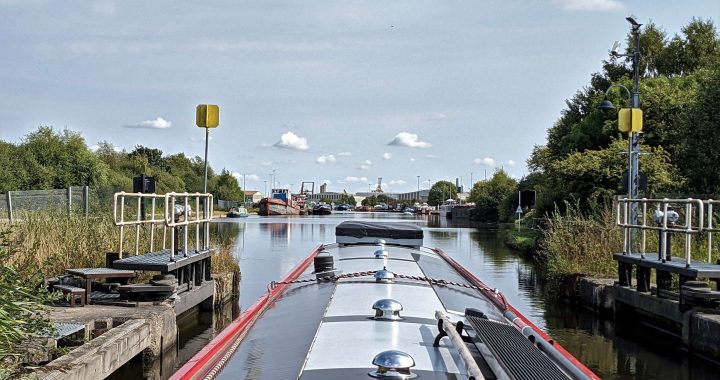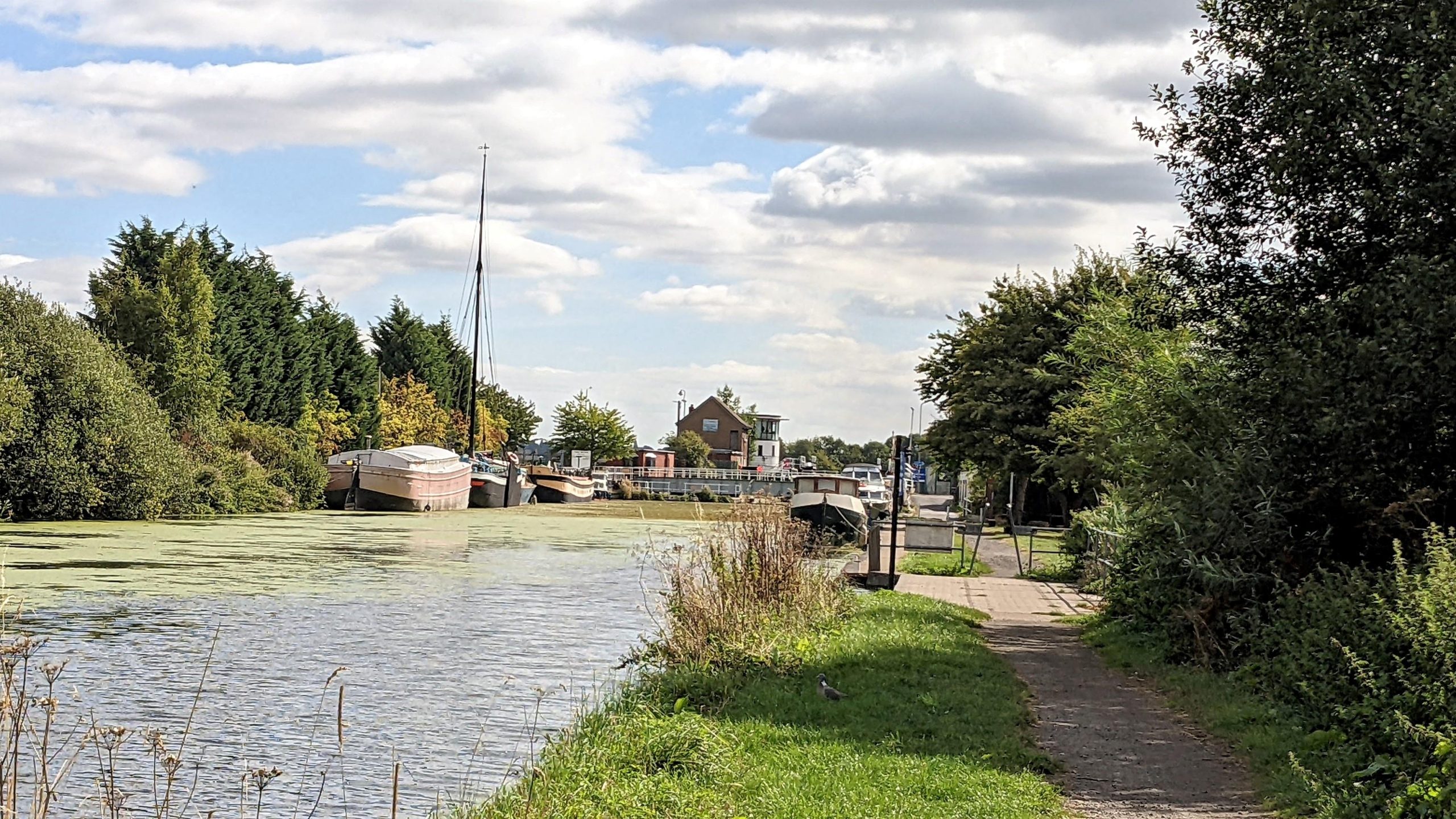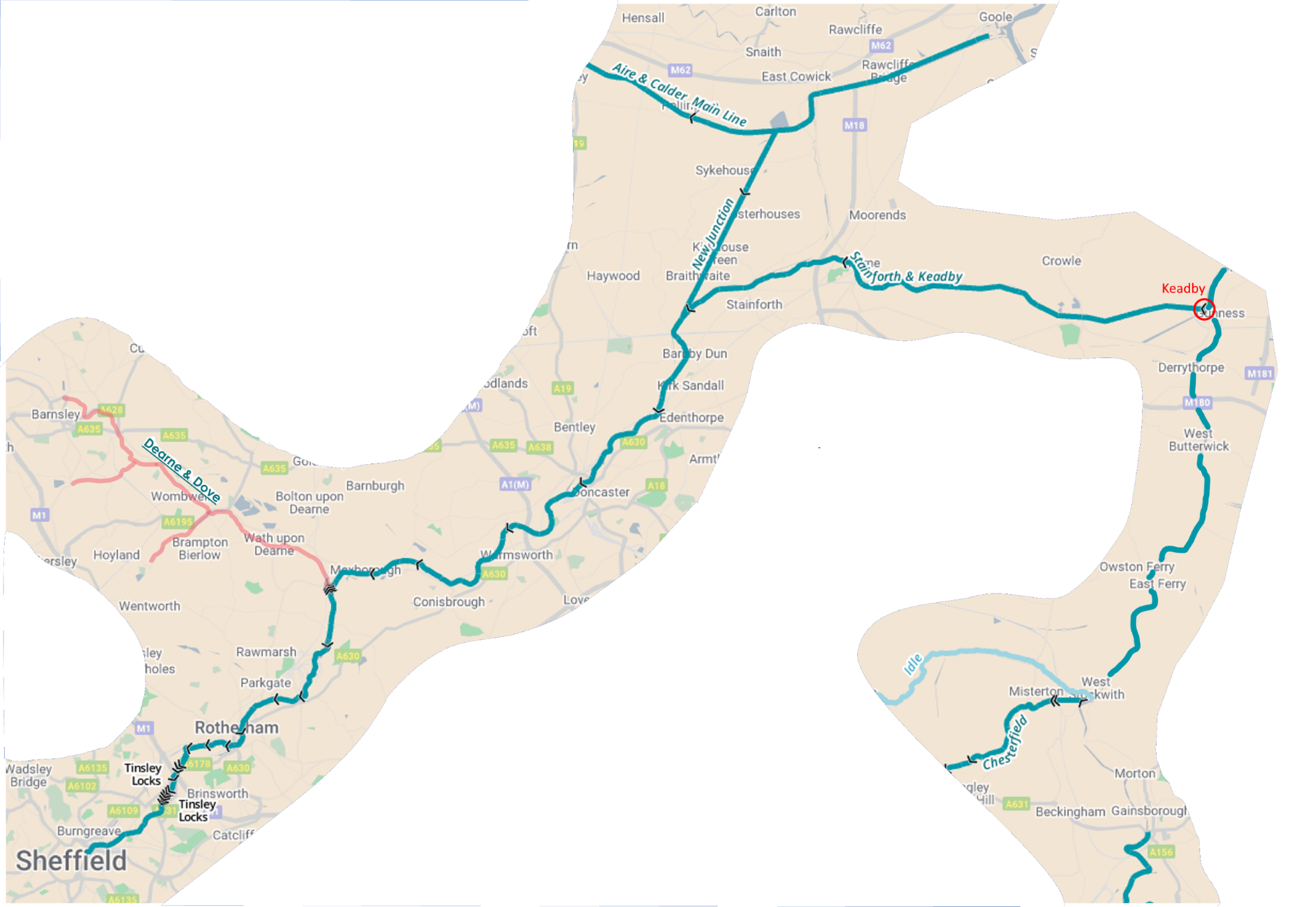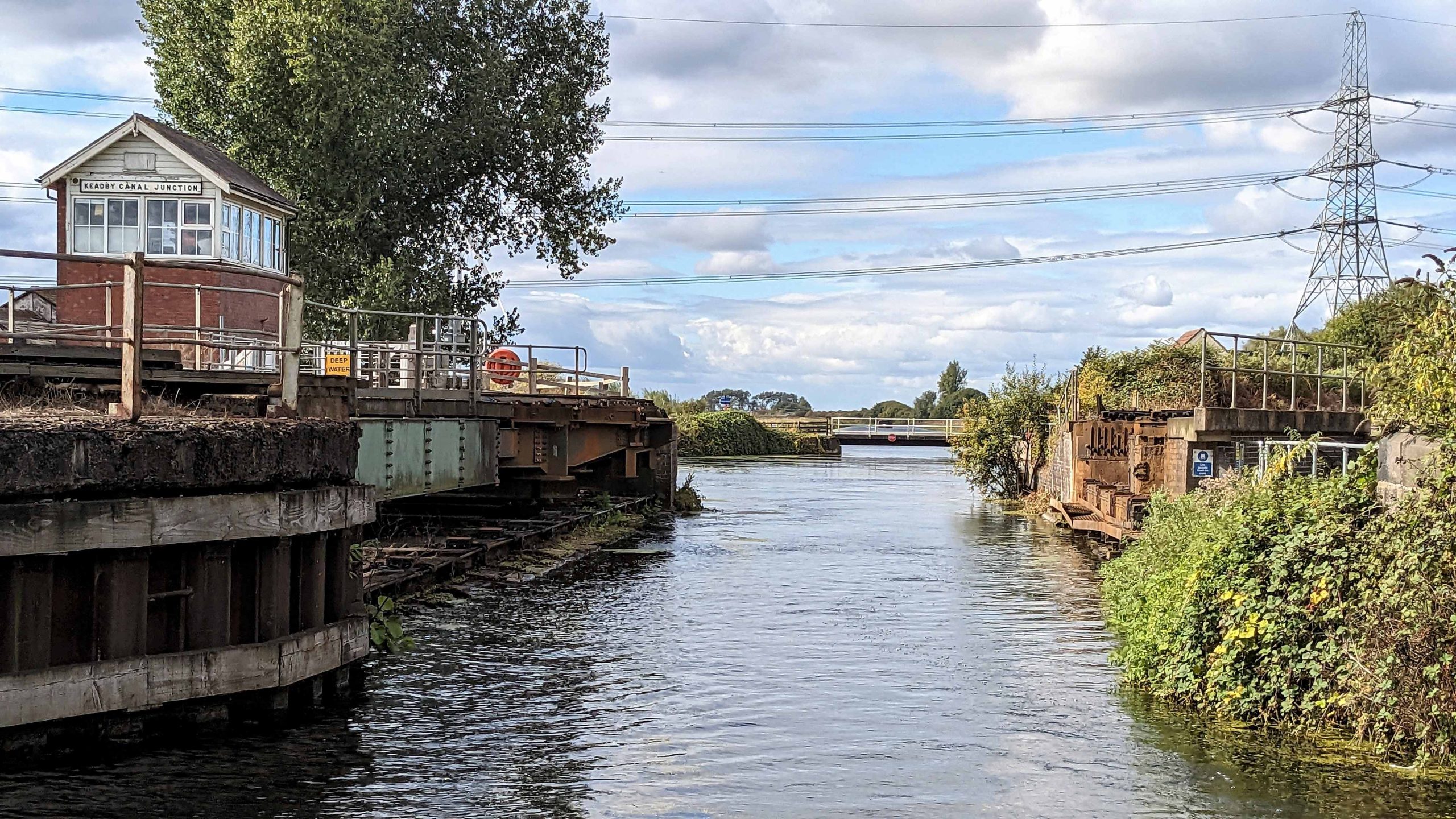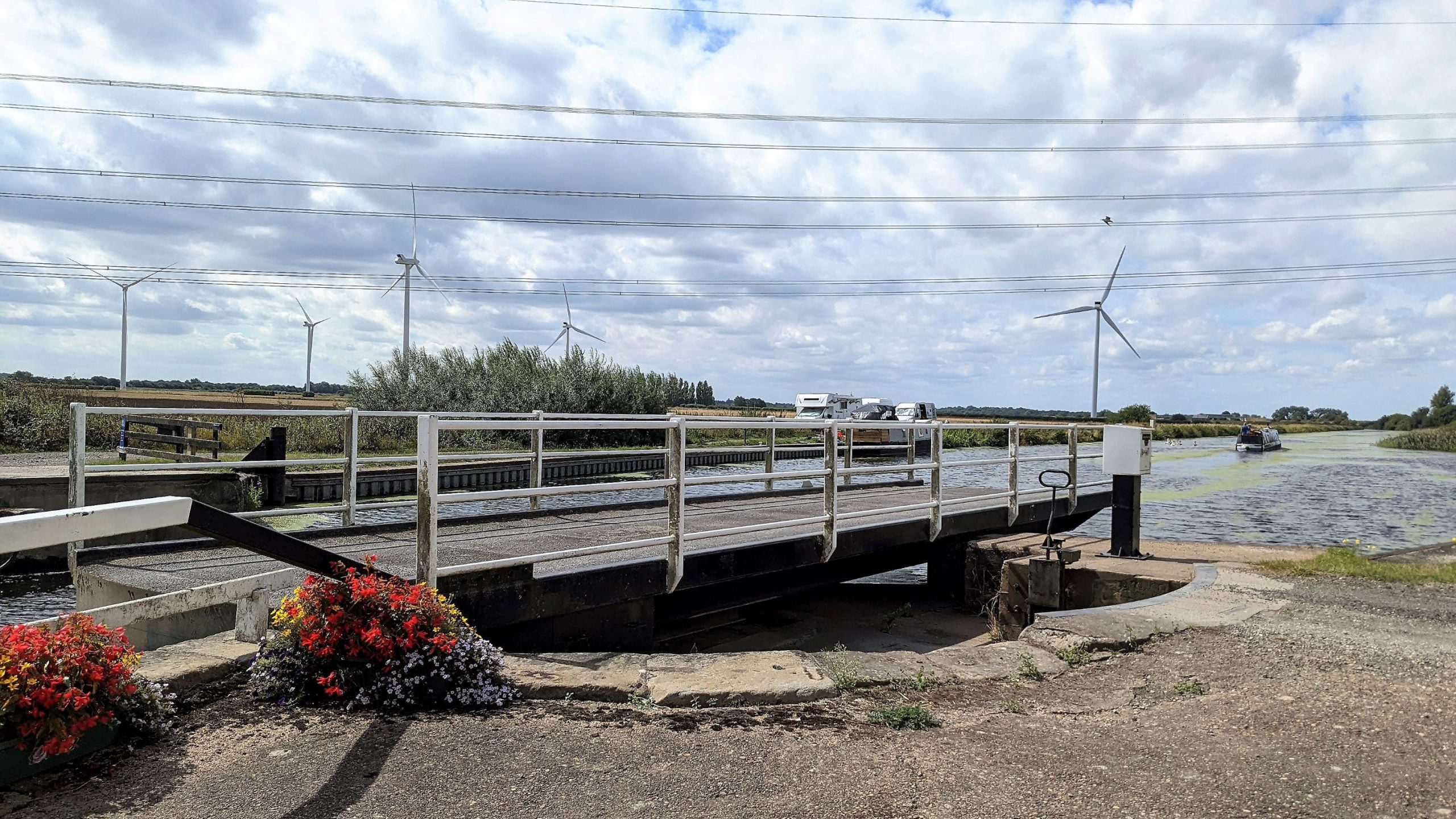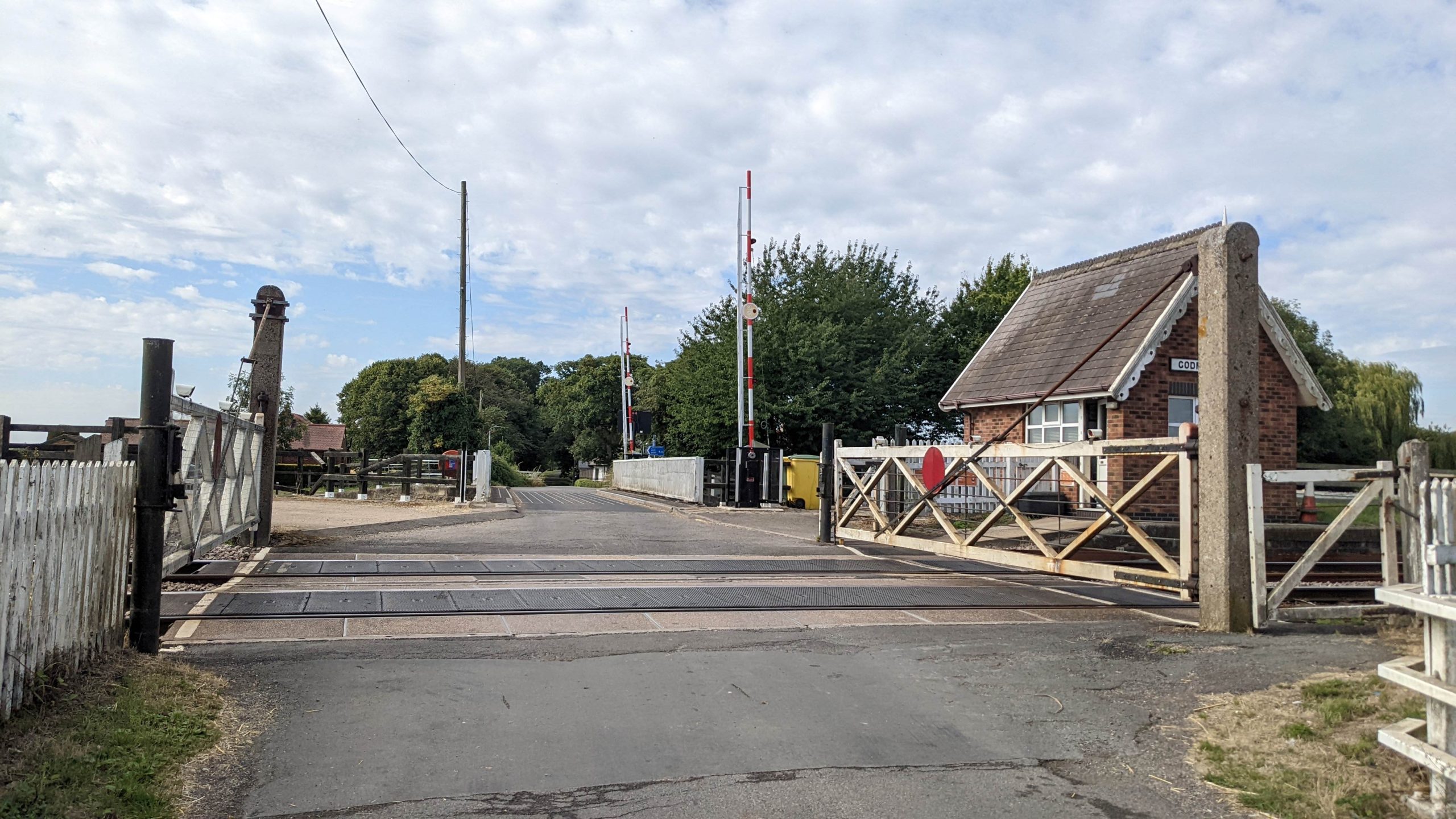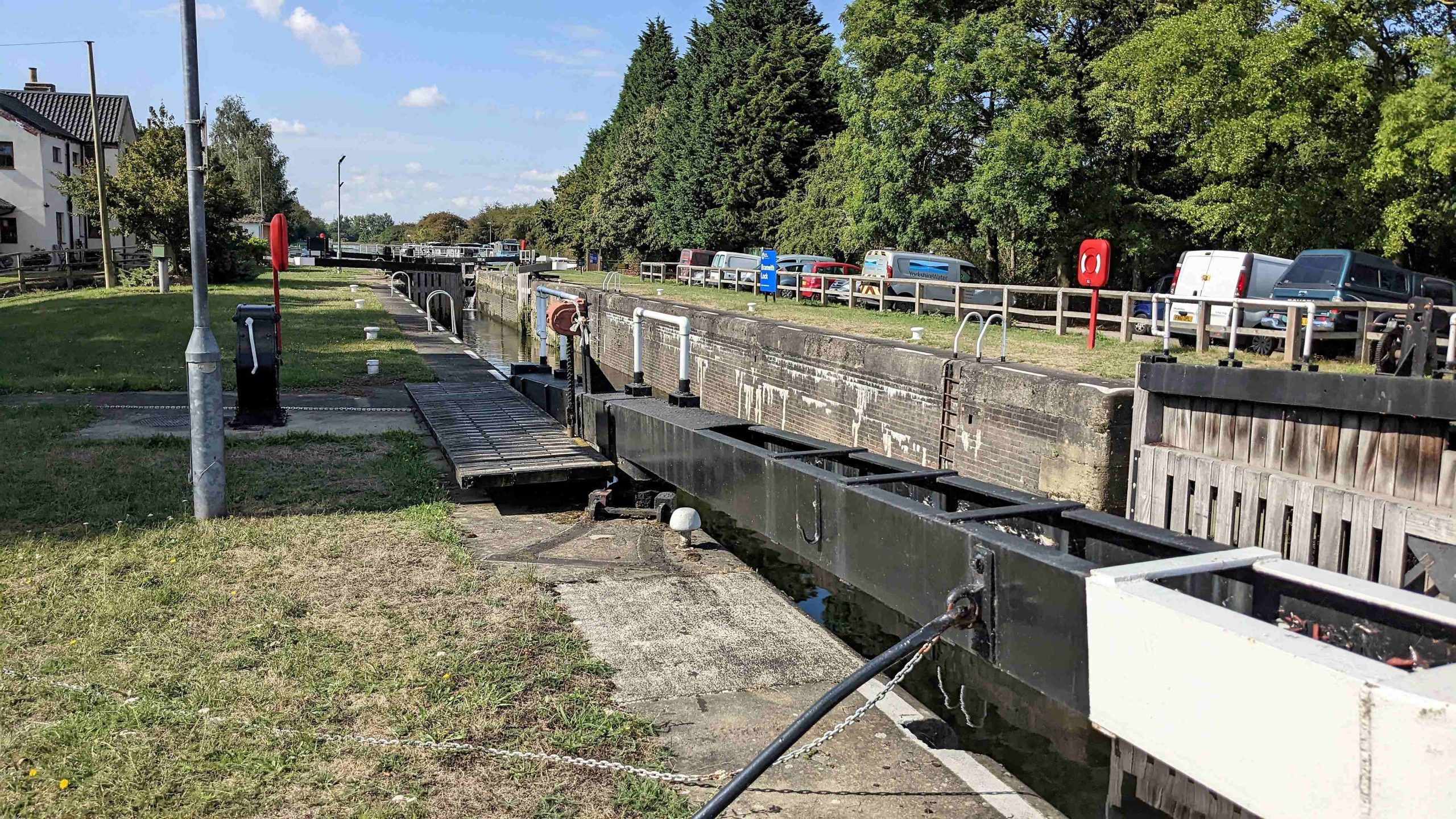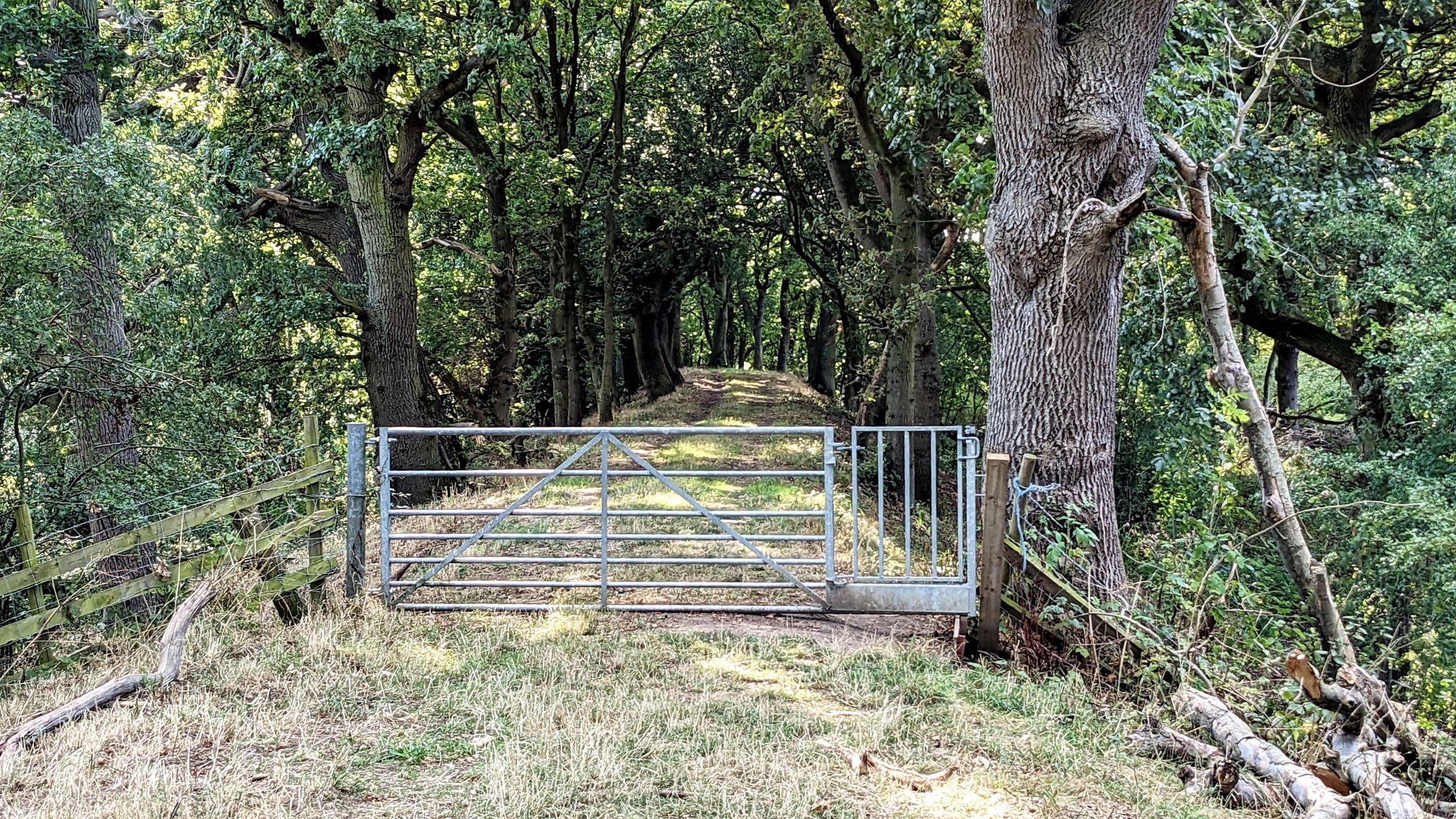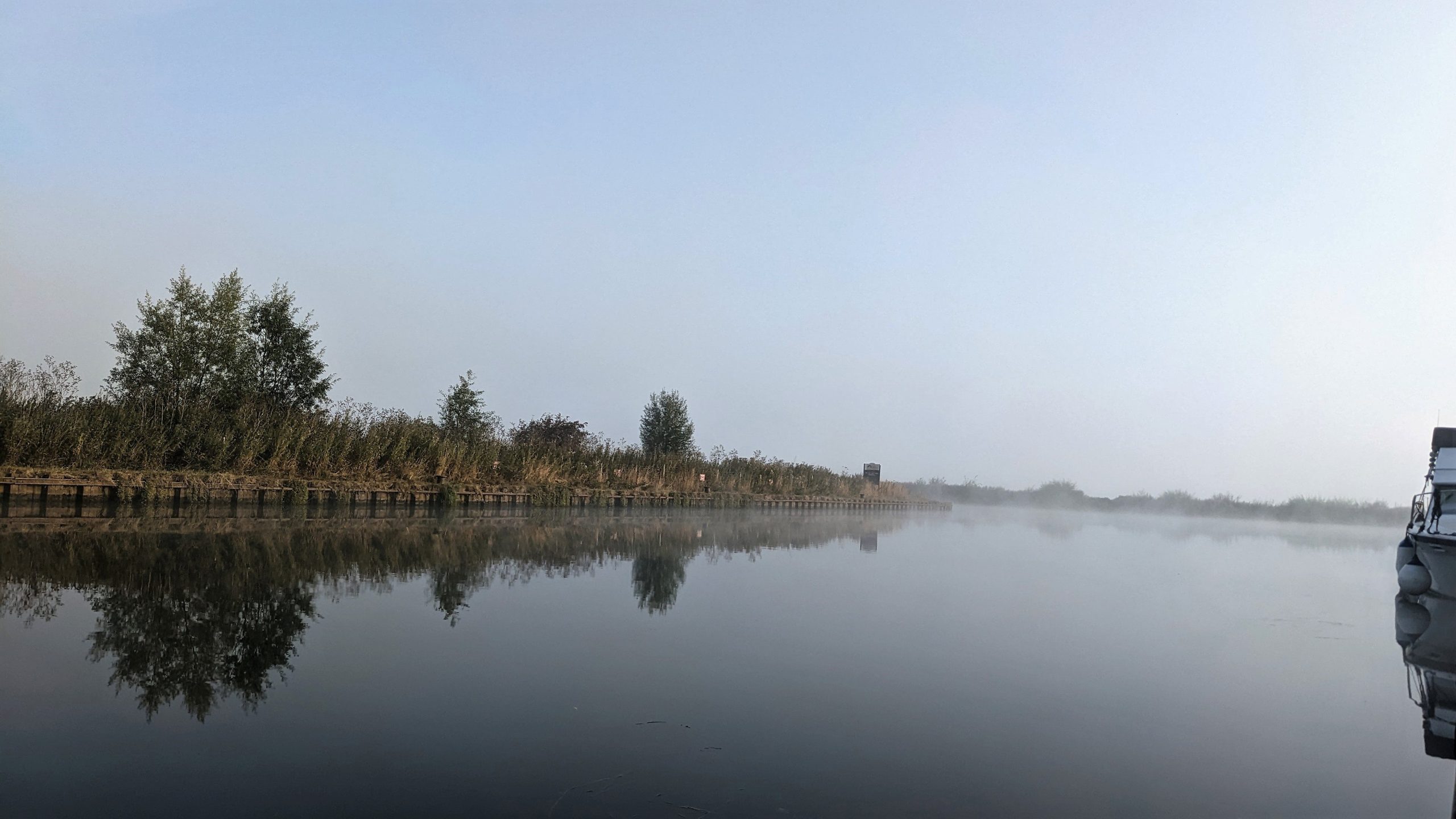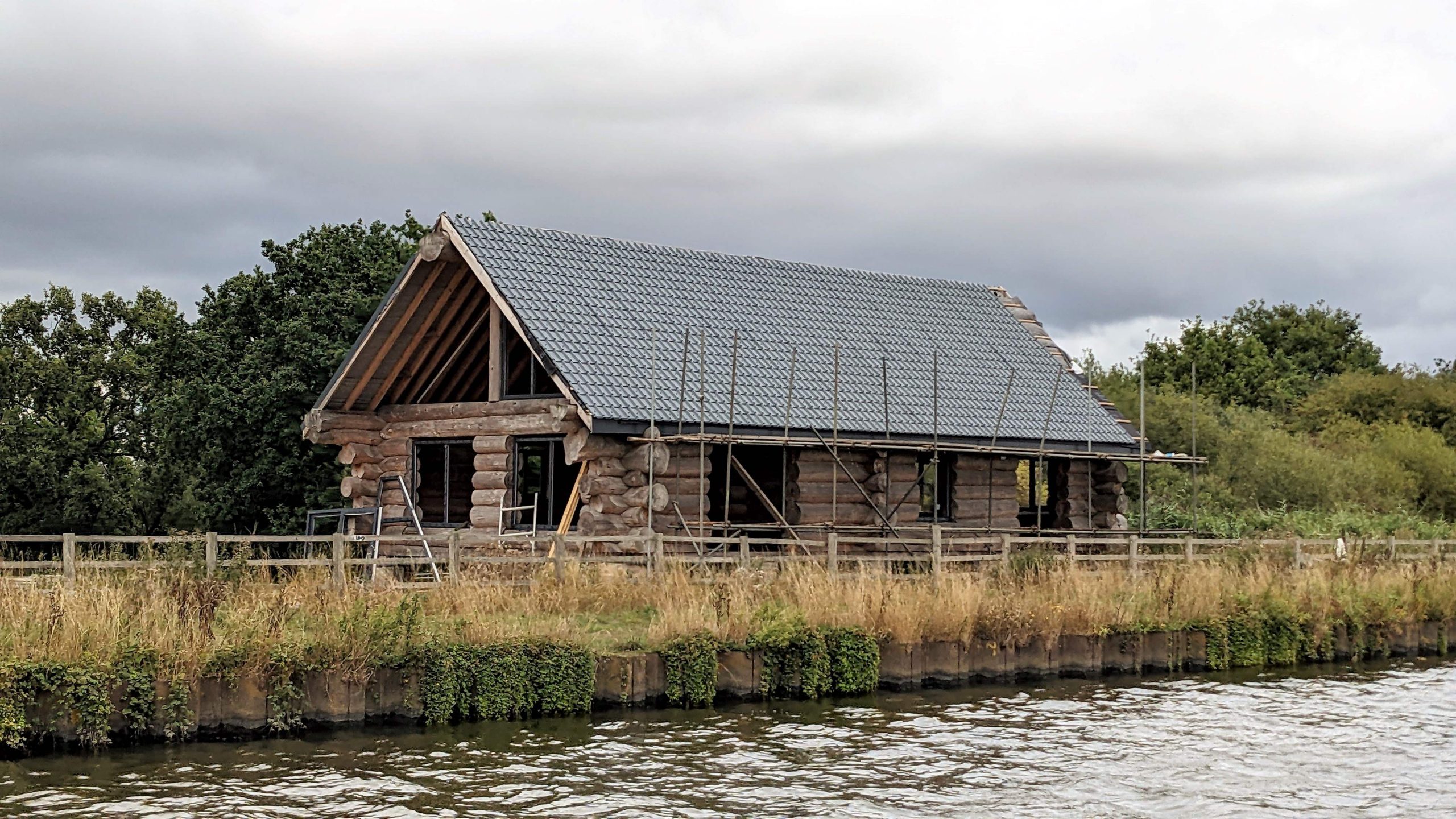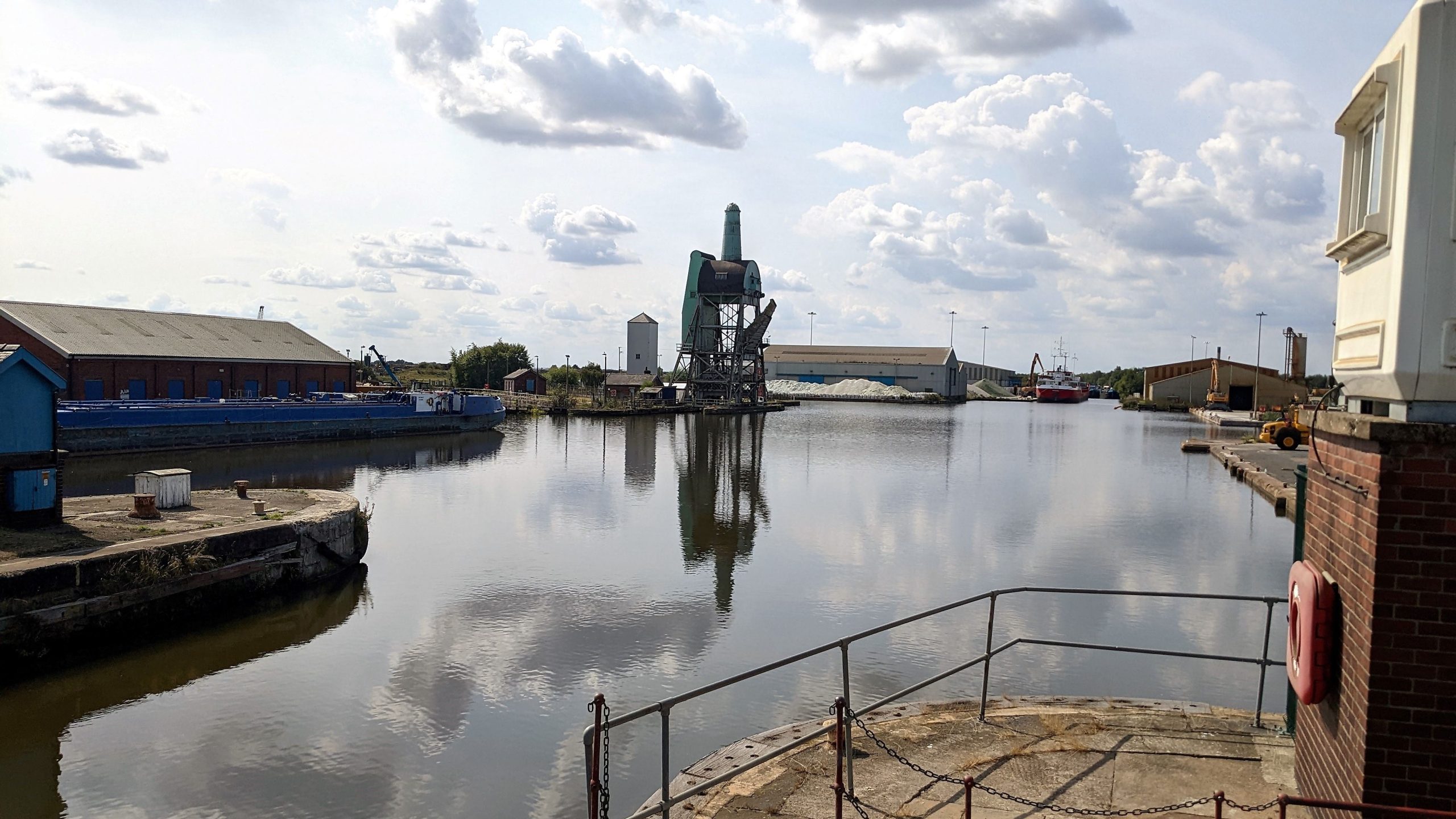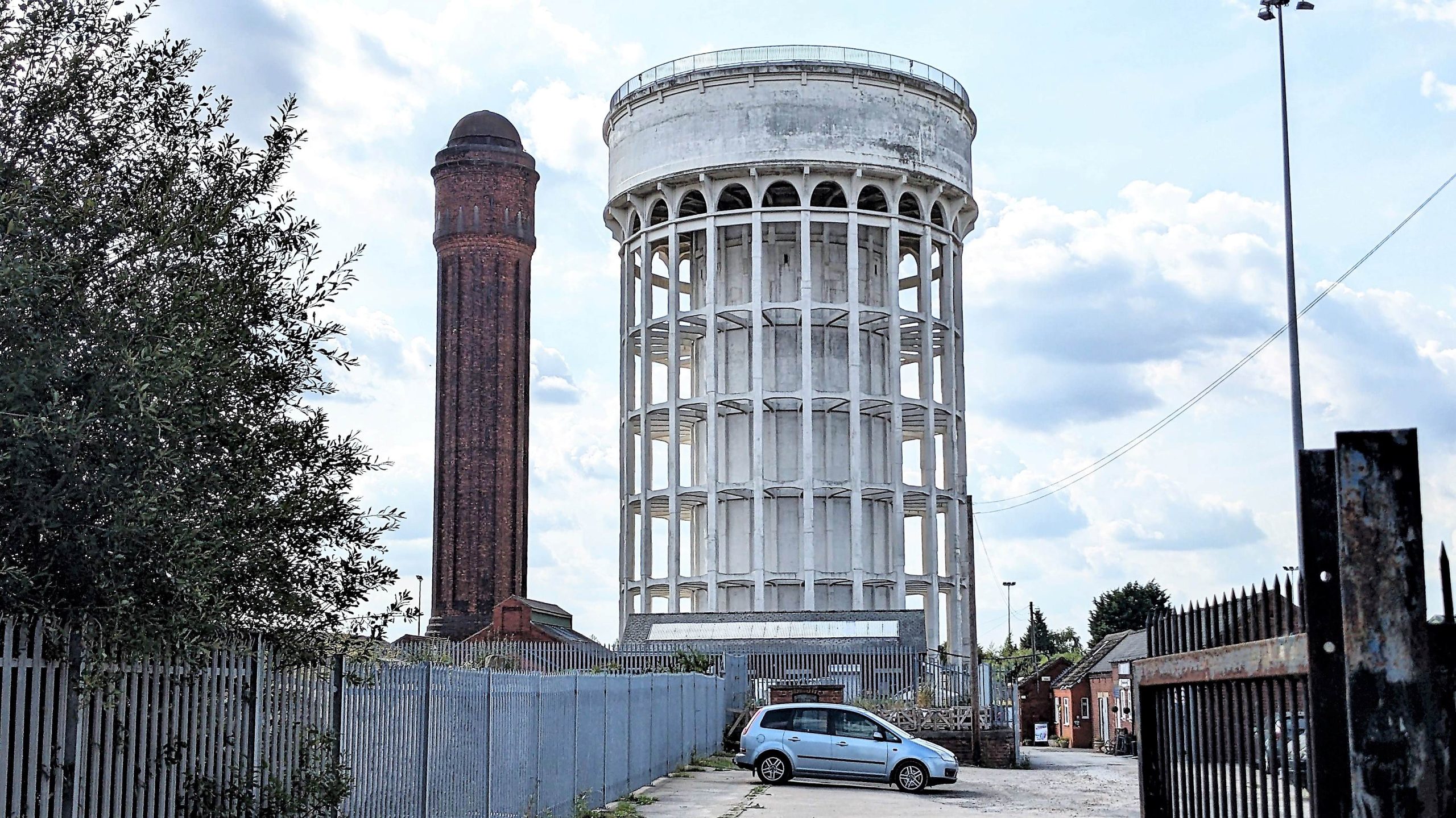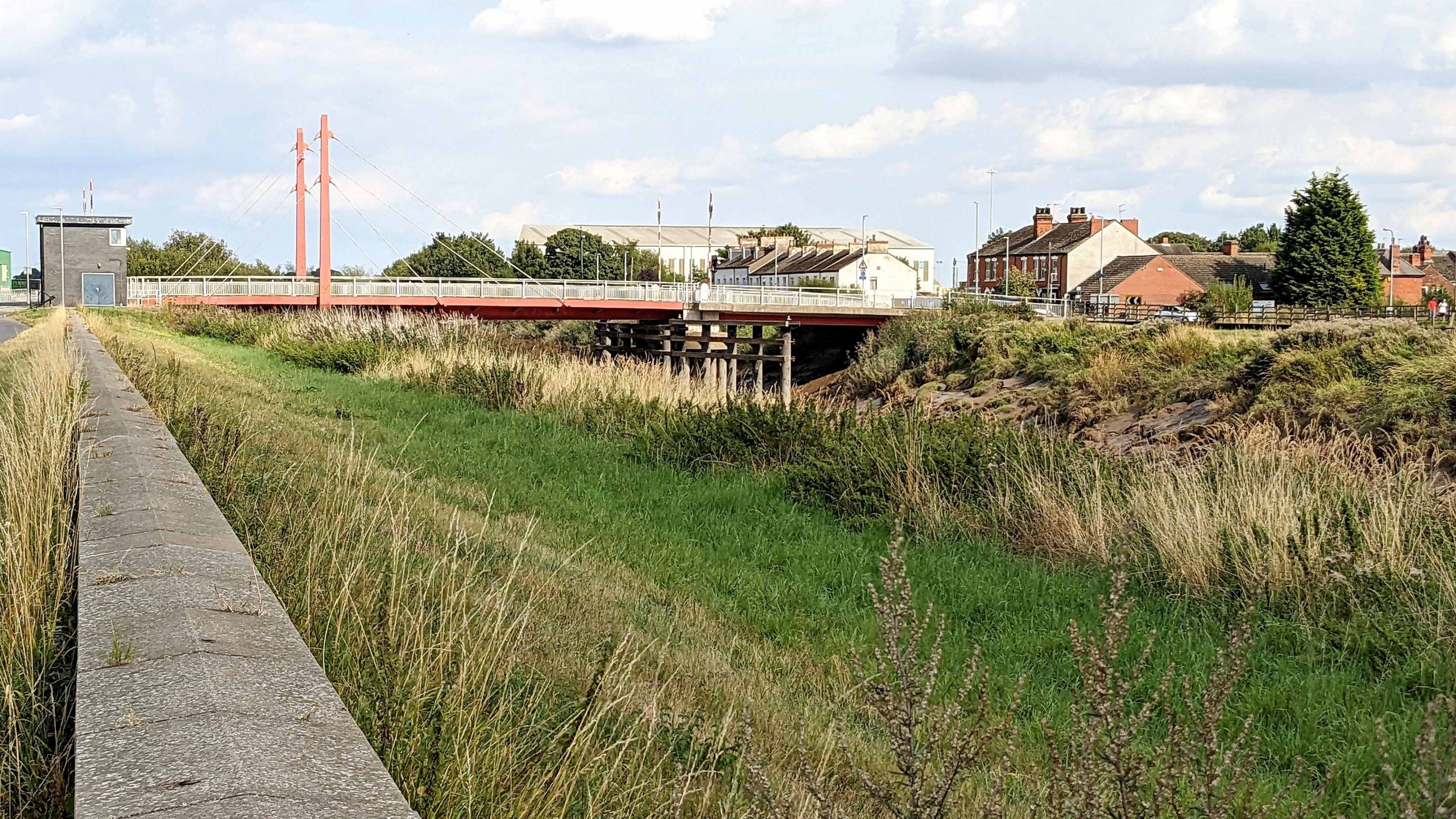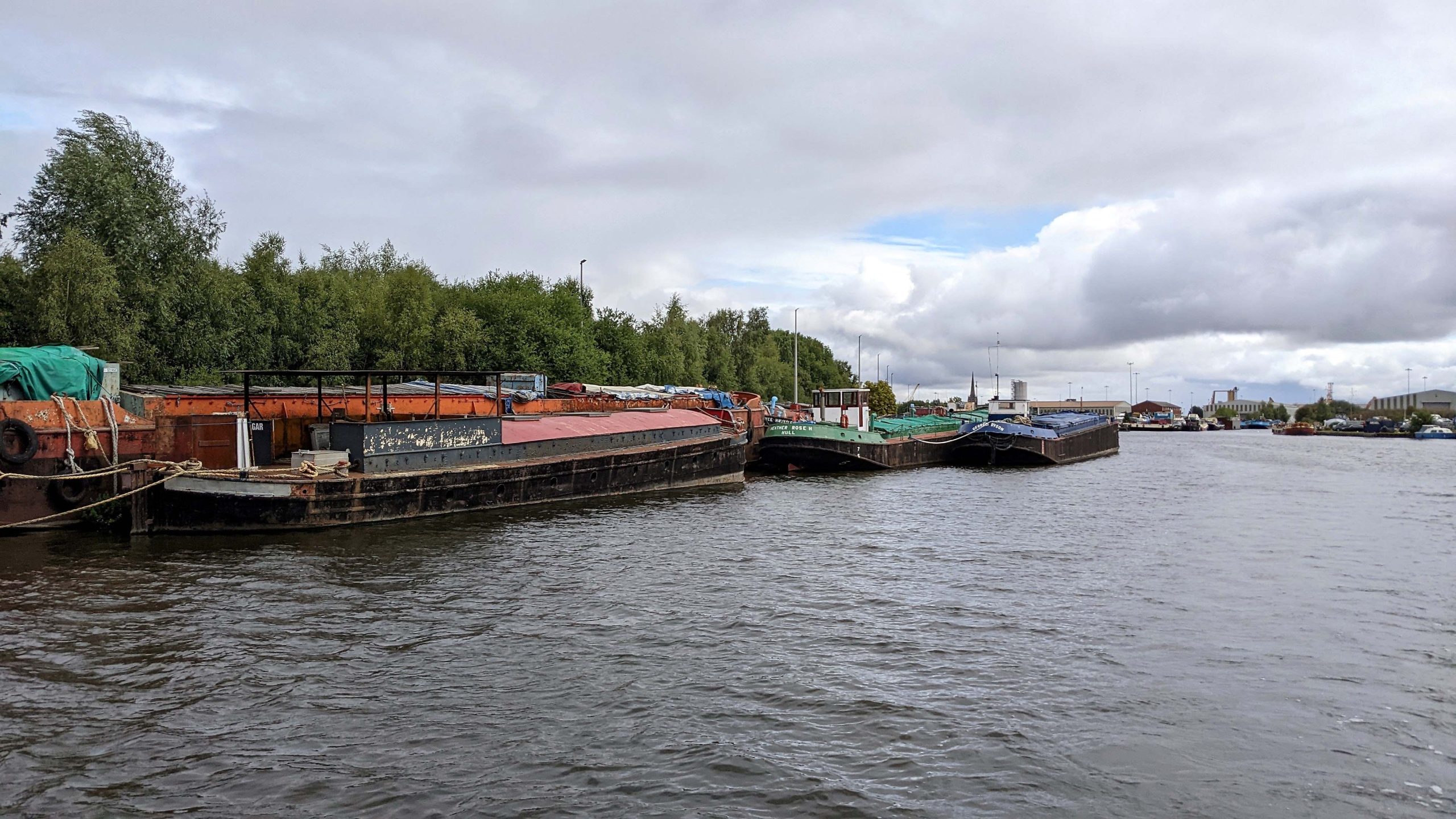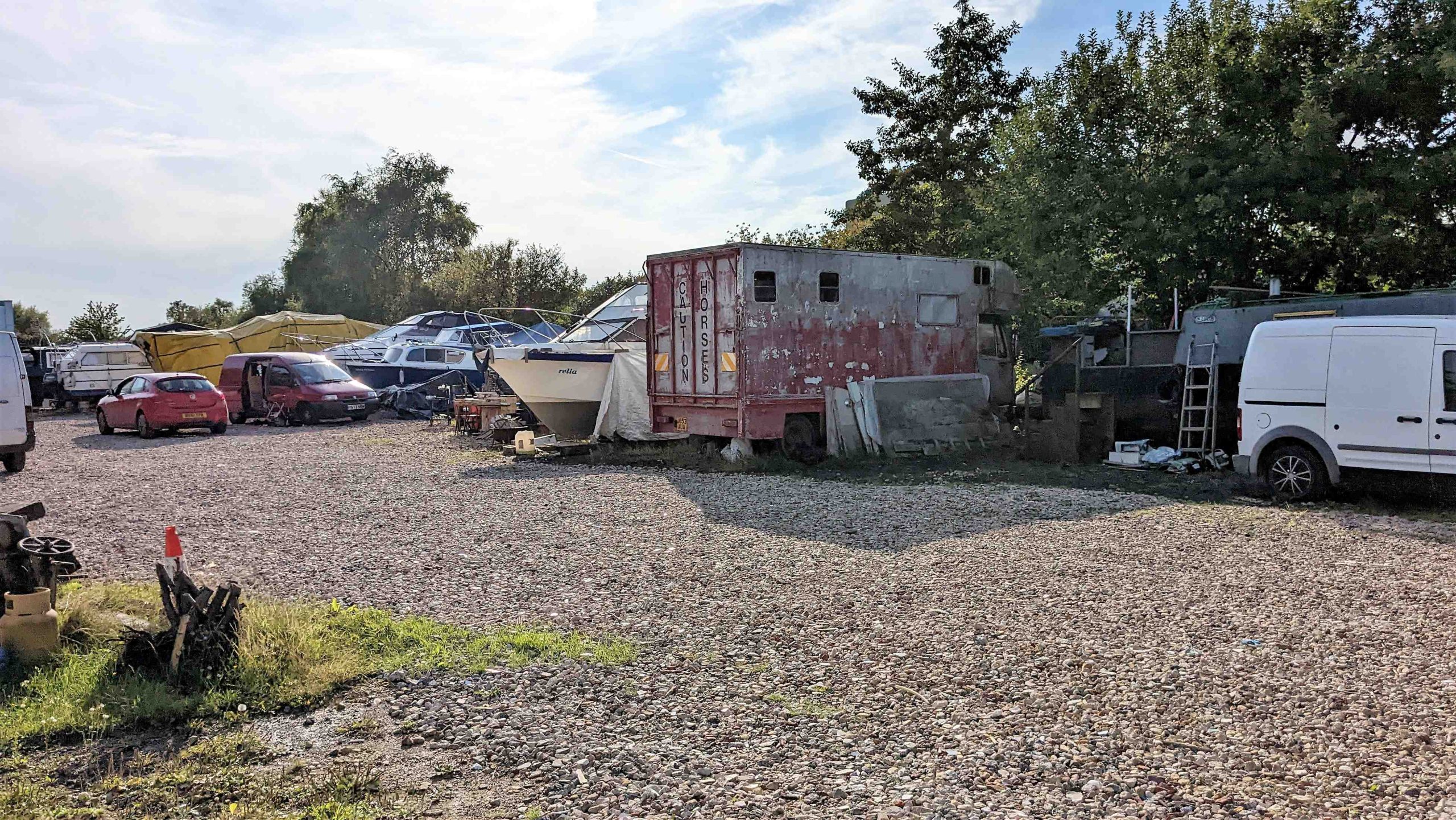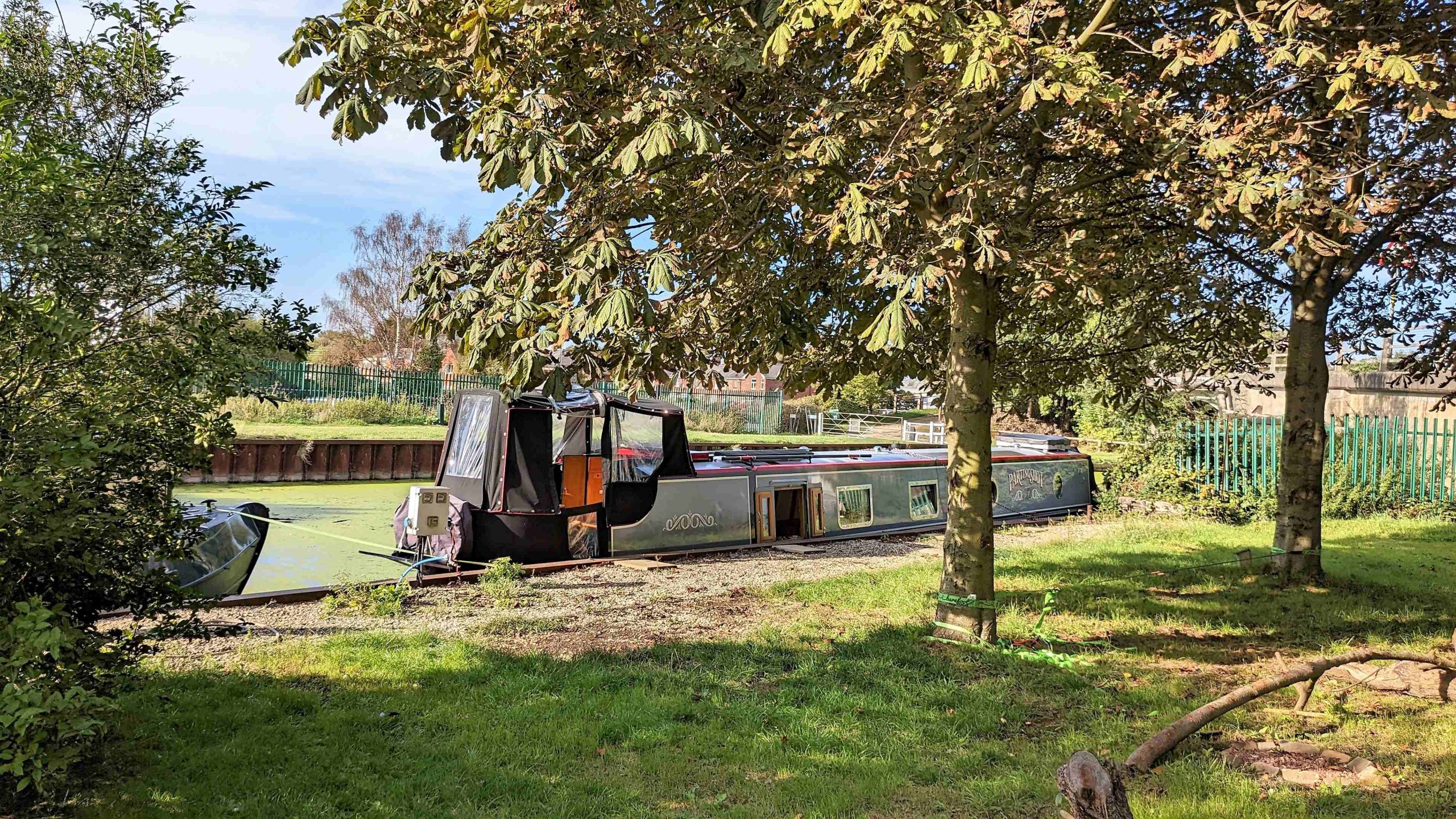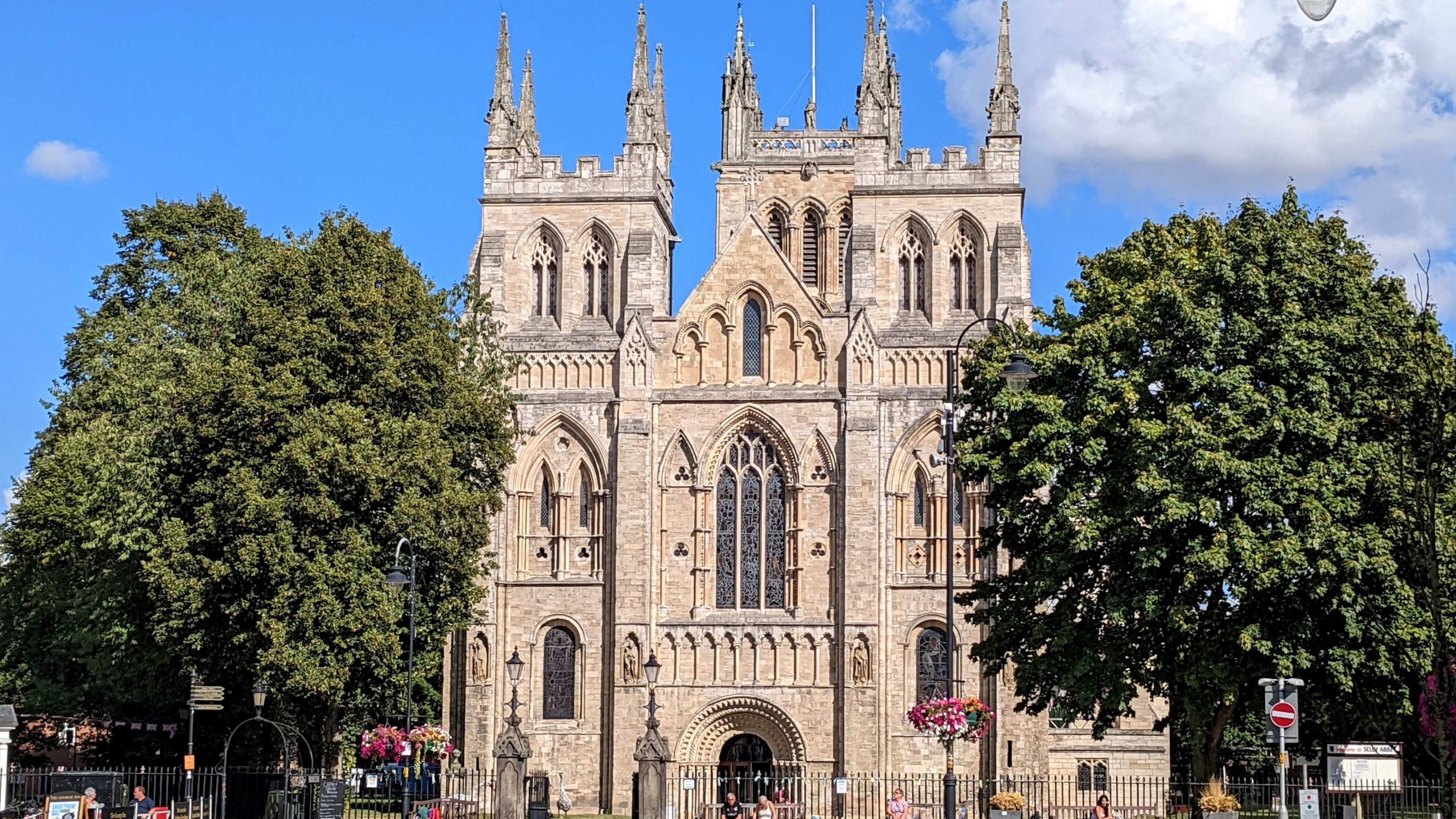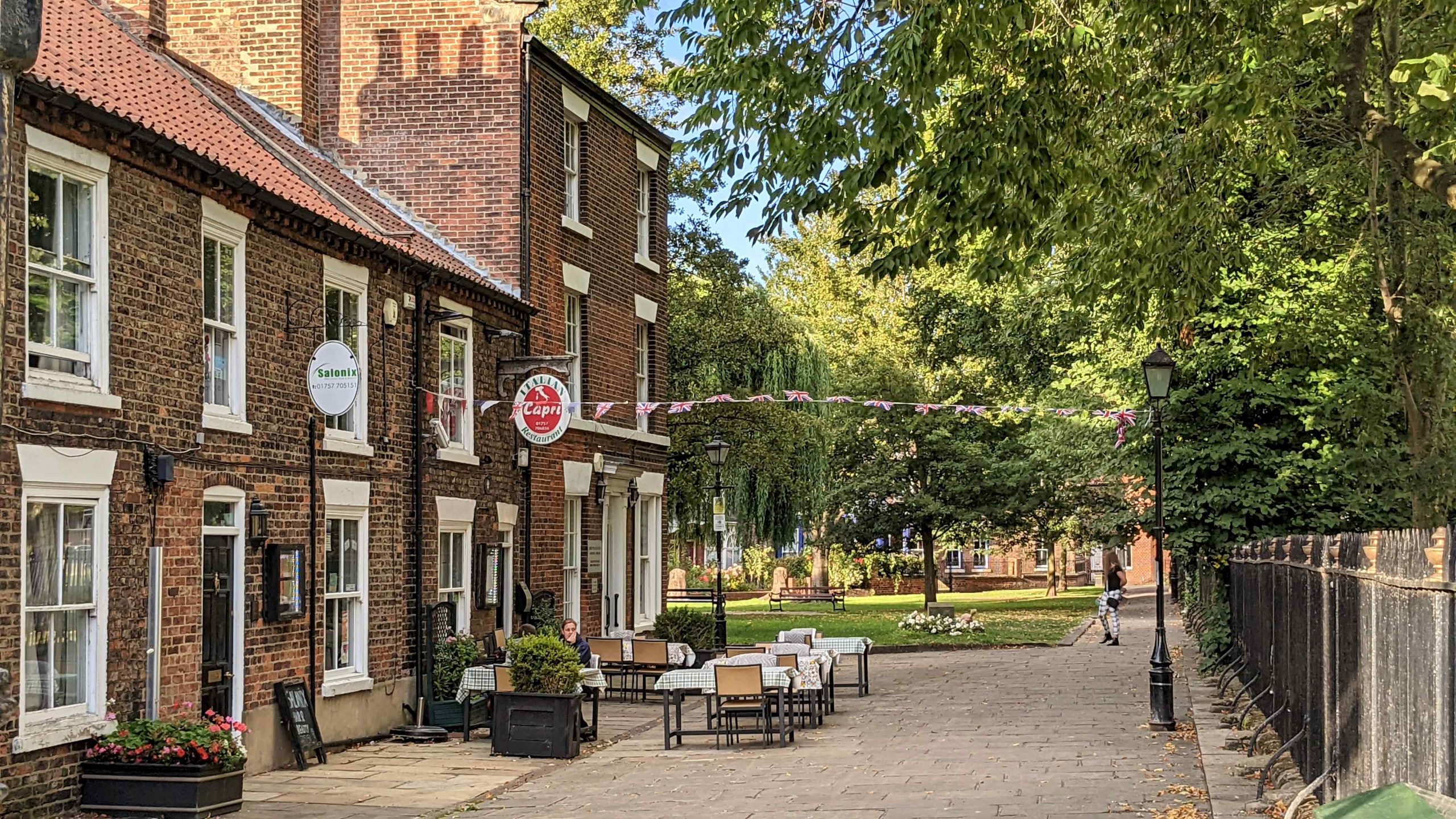Entry Level
There were four boats going out of West Stockwith on Saturday twentieth August. We couldn't all fit in the lock, so we waited for a second cycle and it was quarter to four before we shot out onto the Trent. We had a couple of hours cruise downstream in the afternoon sunshine to get to Keadby Lock. While it was warm and sunny it had got very windy during the day but it was a pleasant enough cruise, guided by the same sort of navigation notes as before, to warn of shoals and obstacles on the way. Keadby wasn't supposed to be quite such a challenge as West Stockwith. The lock was big enough to take three boats abreast so the entrance was much wider but there was a huge wharf in active use by large commercial boats just before the entrance, as well as another warning not to go past the centre of the channel. We still needed to go past and turn back into the current for the approach but with only room for three boats at a time, having turned round, we had to tread water outside for a short while before the lock was ready again for us to enter. Holding station against the flow proved to be rather easier than we thought but we clearly didn't use enough power when the moment came to turn into the chamber, so we had a rather messy entry, trying to get the nose round while being swept against the downstream wall by the current.
We shoved our way in eventually and were lifted up into the thickest weed we had seen since Bardney Lock, the other side of Lincoln. Since the three boats ahead of us had taken the visitor mooring, we had to pull in just beyond the lock gates, where the weed was thickest. It was so dense that the stern would not come close enough in to the side to allow us to get off and deal with the mooring ropes. Behind us was a small cruiser called "Pollonaise". A young man emerged and took our centre line to help pull us in and with his help, we got close enough to be able to get us and Archie on and off the boat fairly easily. He told us that he had recently bought the boat and was having trouble with a flat battery, so it seemed possible we could end up towing him when we moved on the next day.
Having left the lock, we were now on the Sheffield & South Yorkshire Navigations.
These navigations are a system of canals and canalised rivers, broadly based on the River Don, connecting Sheffield, Doncaster and Rotherham with the River Trent at Keadby and also with the Aire & Calder Navigation to the north. They consist of the River Don Navigation from Tinsley to Stainforth, the Stainforth & Keadby and Sheffield & Tinsley Canals, which speak for themselves and the New Junction Canal, which runs, arrow straight, from the River Don Navigation at Bramwith Junction to the Aire & Calder Navigation at Sykehouse Junction to the north. The latter was only completed in nineteen hundred and five, so one of the last to be constructed. There was one other branch, the Dearne & Dove Canal, which ran from Swinton to Barnsley but that finally closed in nineteen sixty-one.
Passing The Drawbridge
On Sunday, having spent the night beside Keadby Lock, we intended to take just a short trip down to Crowle, about three miles further on. However, we would first need to pass through the Vazon sliding rail bridge, which you can almost see from the lock, as it is just a dead straight, half mile away. This isn't only a matter of casting off and heading down the cut when you feel like it. The bridge is operated by Network Rail, not the Canal & Rivers Trust, so the lock and bridge are not neatly co-ordinated, as if anything on the inland waterways ever is.
The Vazon sliding rail bridge is unique on the network although information about it is sparse. It carries the busy Doncaster to Scunthorpe railway line across the Stainforth & Keadby Canal at a sharp angle, so the bridge does not slide along the line of the track, but pulls a whole section of track back on the skew. Another feature of the design is a central walkway that ensures pedestrians and cyclists can continue to use the level crossing over the railway whether the bridge is open or closed. It was built in nineteen twenty-five and is electrically operated, although this is now mains power rather than the original set of sixty-four batteries. While control of the bridge is by a railway signalman from the adjacent signal cabin, an interlock with the railway signalling system ensures that the bridge cannot be opened unless rail traffic is prevented from crossing first. I haven't been able to find much explanation as to why they chose such an unusual design to replace the conventional swing bridge that was first built here in eighteen sixty-six other than it was to minimise disruption to rail services while replacing the original swing bridge.
After nearly eighty years of solid service the whole bridge was replaced in two thousand and four with a very similar design. In two thousand and sixteen, however, there were concerns that extreme high temperatures were causing expansion that was interfering with the bridge operation and in twenty twenty-one Network Rail started essential work to address a structural fault that prevented the signaller from being able to close the bridge, causing disruption to services.
Under normal circumstances, boats approaching the bridge would be spotted by the bridge-keeper or use their horn to attract his attention and then wait for a suitable gap in the schedule to allow the bridge to be opened. Since the original issues were reported there have been different types of restriction in place. At the time we were there, the bridge was only being opened at one o'clock each day. If you missed that slot, you had to wait until the next. It follows, then, that all the boats that came up the lock the previous afternoon had had to moor overnight, so we all set off at the same time, in a little flotilla, to catch the opening. It was touch and go but "Pollonaise" had managed to get his engine started in time so we didn't need to give him a tow. About quarter past twelve "Purple Emperor", another narrowboat, came up the lock with a big Dutch barge.
A little group of three boats went through first and we followed in company with "Purple Emperor". Immediately beyond the drawbridge is an ordinary swing bridge, so the first boat through had to stop and operate it, which we did with good grace. They would, of course, have been obliged to return the favour at the next obstacle but as that was the only one before we reached Crowle, they didn't need to.
Heading To Thorne
The map showed a forty-eight hour mooring at Crowle, which turned out to be about half a boat length, directly under the A161 flyover and already occupied by what looked like a well established shed / cruiser encampment. However, there was an old wharf a little distance before the bridge that offered somewhere to tie up to, away from the road and a little group of houses and opposite the station. We reversed up and got ourselves settled there, shortly before a huge motor home arrived in the car parking area beside us and set up their own home a hundred yards away.
Before dinner, we walked down to the road and across the flyover to Seven Lakes Country Park, just across the canal in Ealand, and the Lakeside Bar, recommended to us as a pub by a local resident we bumped into on the towpath. The country park consists of a large lake with all sorts of accommodation, mainly chalets and static caravans, crammed around it and among some smaller areas of water beyond it. The bar had a vast interior and a lot of outside seating in the sunshine overlooking the activity on the water. The service was good, even in the aftermath of the Sunday lunch trade, while the prices were very reasonable. The whole place had a strong Northern caravan park motif but it was all quite pleasant on a warm, sunny evening, watching what seemed to be mainly jet-skis out on the lake.
There wasn't much else in the little village of Ealand except the station for Crowle, which was a rather bigger settlement a little way to the north. We had chosen to stop here because we had an appointment at the next significant town of Thorne, about seven miles further on, that wasn't until Wednesday. We thought we would spend Sunday and Monday night at Crowle before moving on to Thorne, itself, on Tuesday ready for the start of the next day.
The weather had changed a little and we had a short shower on Monday morning, before we headed out on a circular walk along the canal to cross at the next bridge and loop back through Crowle and back to the canal via Ealand. On the way down the towpath Archie got so excited that he managed to slip on the bank and drop into the canal. Once again he chose a moment when we were both looking the other way for a second, so we looked back to see he had disappeared and then spotted his head bobbing up and down as he tried to get out of the water. By the time I reached him he was out and we were lucky that the water here wasn't that cold, was much cleaner than we are used to and the weather was still quite warm to dry him off.
We reached the next bridge, Godnow Swing Bridge, and crossed to the opposite bank and over the railway at the level crossing. Having crossed via the Vazon sliding bridge the railway runs immediately parallel to the north bank of the canal most of the way to Thorne. What took us by surprise, here, was that the level crossing for this minor road across the railway was manually operated when an approaching train whistled. We came to realise that this was true of most of the level crossings that we passed, as we followed the route west.
There are large numbers of crossings, around the country, that do not have someone standing by to supervise the passage of each train. To the untrained eye, it was very difficult to see how the manpower required to operate this way, presumably at least three full time staff per crossing, seven days a week, could be justified here. Perhaps this is one example of the sort of practices rail companies are seeking to amend as part of any settlement on overall pay claims.
It took a couple of hours to complete our walk and we didn't stop to explore Crowle, itself, very thoroughly. We spent the afternoon doing a few maintenance chores back at the boat. We had been joined by another narrowboat called "Porth Ceri" and we were surprised to see that the motorhome was still in the car park and then stayed for another night. It didn't seem like the sort of spot that would be an attractive place to stay longer than overnight. For us, our options are limited but with one of these beasts, we had assumed that you would have greater flexibility to find a place to set up camp away from the flyover and railway lines.
On Tuesday, after a wet and humid night, we got ready in a grey, damp and very still morning to head for Thorne. Just as we cast off, so did "Porth Ceri". With five lift or swing bridges on the way and two more through Thorne, itself, this was a godsend. We leapfrogged down with them, opening alternate bridges for one another. We even managed to dodge one as another boat coming from the other direction got to that one first. As a result, we were moored up in Thorne, just short of the yard we were taking the boat into tomorrow, before noon. We were on the outskirts of the town, opposite an extensive area of private mooring, two or three abreast and beside a single row of private houses, with a large area of green space running between the canal and the buildings. Just ahead, between us and the Canal Tavern, was a small park where we could let Archie off and next to the pub was the boatyard, itself. After lunch, I went and checked in to get our instructions for the morning and then walked up along the canal to a marina at the far end of town. It seemed quite a nice, tidy place to me but Sue had gone into town for some shopping and returned with a tale of closed down shops and a deserted high street that had seemed quite depressing. For dinner, we visited the Canal Tavern, newly refurbished and very welcoming, in a northern style, where we found the crew of "Laze Daze". While we were at Crowle we saw "Laze Daze" go past with a couple at the tiller, who seemed to be having a particularly good time and shortly after that they came back again. In all they had passed us four or five times, which is unusual. It turned out they had just bought the boat, which was moored in Staniland Marina in Thorne and this was their first time out to try and get used to it. They had had a great couple of days but were now heading back to work. We could only commiserate.
At Our Service
The next morning was grey and damp again but a little fresher. We were up early to move down into the boatyard for nine o'clock, as instructed. For the last thirty months and fifteen hundred running hours, I had been changing the oil and filters, according to the service schedule, checking what I could of the condition of various parts of the engine. No-one who knew what they were doing had laid a spanner on it in all that time so now, with the third major seven hundred and fifty hour service due, I had decided it was time to get a full professional service and inspection done. We had asked for the works, including changing the anti-freeze and checking things like valve clearances and propeller shaft alignment, so we expected it to be quite a long job as well as costly. Hopefully, it would be worth it for the peace of mind. It was a long job, indeed. Archie was left alone for a lot of the time, as Sue went back and forth to the laundrette to feed more coins into the dryer. Another boat came alongside for fuel, as we were moored right in front of the pump. Lunch came and went, then tea break. Finally the school run brought proceedings to a halt for the day, with just a couple of things outstanding, the prop alignment and replacing the Perspex screen in front of the electrical bus bar, which our engineer had broken in the process of checking the batteries. We were left to spend the night on board in the locked yard, although we did have pedestrian access to the outside via the secure CRT facilities adjacent. We also had the added bonus of a shoreline to enjoy unlimited electricity for the night.
The sun had come through for quite a hot afternoon but after heavy rain for an hour or two in the evening, Thursday started off dull, grey and very mild and muggy. Oliver turned up to finish the job at nine o'clock and we were all done by ten-thirty. Having added seventy litres of diesel and a replacement cable, one vital spare part that we should have had on board long before this, to our tally, we left Thorne with a considerably lighter wallet, at least. We moved on three or four miles, past Stainforth, where we noted a nice looking pub with mooring outside and we moored up on the towpath at Lower Bramwith, just in time to get the pins in and the covers up before a long spell of heavy rain that lasted until four o'clock. That gave me a chance to get the saw out and make some adjustments to the wooden battery cover which, following a combination of installing replacement batteries and a minor adjustment to the cabling undertaken at Thorne, no longer seated properly. It appears to be standard, in the boating world, that if you spend money having work done for you, then you will come away with some extra work for you to do, yourself, as a consequence. I suppose, that just means that I really should try harder to gain the confidence to do more of these things myself.
Going To Goole
Friday was a bright, sunny day from the start. We stayed where we were and worked on the boat during the morning but decided to move up through the swing bridge, just ahead, before lunch. There is a CRT service facility right beside the bridge with quite a long wharf. There were three CRT workmen in the small office there so I asked them if it would be OK for us to moor at the far end of the wharf where a secure gate opened out onto the main towpath. They said that would be no problem, as there was plenty of room for boats to use the water point, so we finished getting water and moved down there for the Friday night.
Between Stainforth and South Bramwith the canal runs roughly parallel to the River Don, which splits again into the old course and the current, straightened Don. There are footpaths on the map that follow the river and also one that runs along the old route. We set out to try and follow the paths back to Stainforth via the loop of the old Don and return along the new course. This was shown on the map as a defined route for the Thorne Circular walk. Following the embankment above the new cut, at first, was fine. Several attempts to find the old footpath failed, however. The whole area was just too overgrown and despite some waymarks indicating the route, it was impossible to make any progress for more than a few yards. Beating our retreat up onto the embankment we settled for following that down to the road at Stainforth High Bridge. We did cross over the canal and had a look around for what was shown as a traffic free cycle route to follow the canal back to Bramwith on that side. There was no trace of that either, however. The area was particularly unattractive and there was a lot of fast, noisy traffic, which we assumed was because it was four o'clock, so everyone was rushing home for the Bank Holiday weekend. We crossed back again and found our way down onto the towpath to take us back to the boat, feeling slightly disappointed.
Saturday was warm and sunny with enough breeze to stop it feeling too hot. We moved up into Bramwith Lock, which seemed enormous. It was obvious that these canals were generations on from the original eighteenth century pioneers, with a width and depth to fully exploit the commercial potential of this form of transport.
By the time we had got the lock emptied and open "Roke" had arrived, with a large and lively crew on board and they joined us inside. Chatting, as the water rose, we learned that they were in the vanguard of a boat club outing, with two other narrowboats and a wide beam, all crammed with Bank Holiday boaters. They were heading for a long, popular mooring at Pollington, on the Aire & Calder, so could be expected to be following us as far as Sykehouse Junction
Shortly after Bramwith Lock we came to Bramwith Junction where there is a sharp right turn, through around three hundred and forty degrees, onto the New Junction Canal. On the map it looks intimidating but the waterways are so wide here that it poses no real issues at all. We generally think of the canals gradually being overtaken by the railways and bought out by them, as the waterway trade declined into obsolescence. Here, in South Yorkshire, the navigations had already been in the hands of the Manchester, Sheffield and Lincolnshire Railway and its predecessors, for decades when long-running dissatisfaction among their users led to proposals for improvements in eighteen eighty-eight. It was the newly formed Sheffield and South Yorkshire Canal Company Limited that obtained an act of parliament allowing them to eventually acquire the navigations from the railway by compulsory purchase, with the aim of upgrading the locks to take small coasters. Five years later they finally had control but not the capital to carry out their original ambitious plans, so traffic was limited to vessels of one hundred and ten tons. However, they were able to make some improvements. This included the building of the New Junction Canal connecting them to the Aire & Calder Navigation which, in turn, gave direct access to the large port and extensive handling facilities at Goole.
The route of the New Junction Canal is through relatively flat, open countryside, so it could be cut dead straight for five and a half miles. There is an aqueduct at each end, one over the Don to the south and another over the Went to the north.
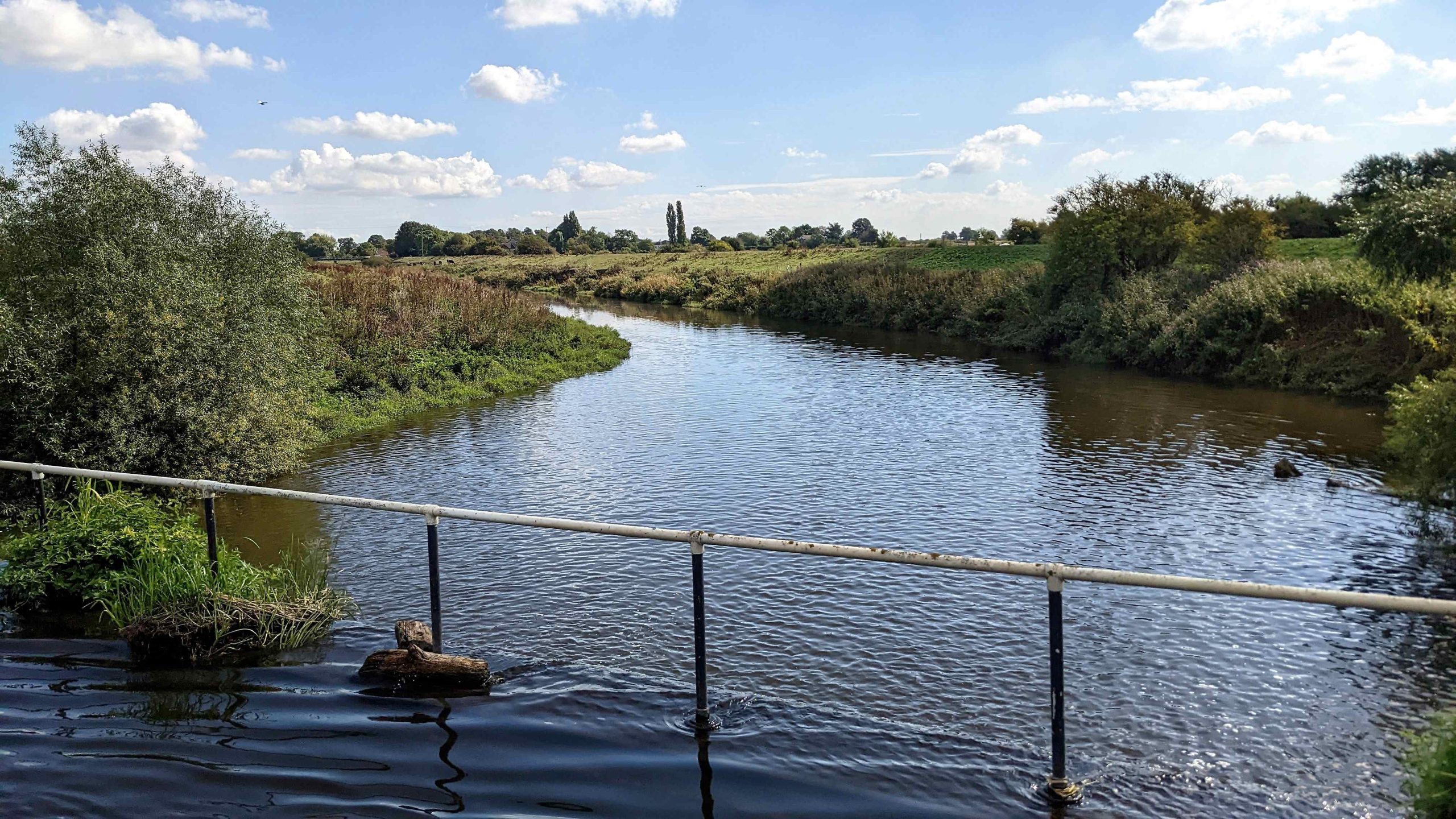 It is very much built for commercial use by large boats. Nevertheless, it still had to cross various existing road routes so there are six lift or swing bridges along its route, thankfully electrically operated these days, as well as one lock. The lock is often manned, as it was on this occasion, particularly as it has one of the swing bridges sitting right on top of it. This makes it more complicated to operate, as there is an interlock preventing the automated operation of the lock until the swing bridge has been opened manually. The lock can accept vessels up to two hundred and fifteen feet long and twenty-two feet six inches wide. When we arrived it was full of cruisers, so we had to wait for them to pass through. Then, naturally, the lockkeeper wanted to wait for the excursion flotilla, which he could see in the distance, in order to best manage the water resources. We didn't have to wait too long, however, before they were all crammed in and we dropped down the four feet six inches to the lower level. Here, we pulled over and stopped for lunch, allowing the little group of boats, laden with party people, to proceed at their own pace.
It is very much built for commercial use by large boats. Nevertheless, it still had to cross various existing road routes so there are six lift or swing bridges along its route, thankfully electrically operated these days, as well as one lock. The lock is often manned, as it was on this occasion, particularly as it has one of the swing bridges sitting right on top of it. This makes it more complicated to operate, as there is an interlock preventing the automated operation of the lock until the swing bridge has been opened manually. The lock can accept vessels up to two hundred and fifteen feet long and twenty-two feet six inches wide. When we arrived it was full of cruisers, so we had to wait for them to pass through. Then, naturally, the lockkeeper wanted to wait for the excursion flotilla, which he could see in the distance, in order to best manage the water resources. We didn't have to wait too long, however, before they were all crammed in and we dropped down the four feet six inches to the lower level. Here, we pulled over and stopped for lunch, allowing the little group of boats, laden with party people, to proceed at their own pace.
We had wondered about staying where we were overnight but there was no phone signal there so we set out again, intending to moor at the junction an hour away. As we emerged from the aqueduct who should we find on the mooring there but our erstwhile travelling companions, who had decided to stop here for the weekend, rather than go on to Pollington. There was just space left for us to get in between their fleet and a couple of other large cruisers that had already been moored up there the night before and had been enjoying a peaceful, sunny Saturday. We pulled in and tied up for the day as the boat club got themselves all set up with the barbecue going, the children screaming and loud music blasting from an impressive sound system on one of the narrowboats. A little later another large cruiser arrived which we came to realise was meeting the boat club trip and they had probably been hoping would have settled into the space we now occupied, so they came alongside one of their friends' boats and breasted up with them. They brought with them more loud children and a dog that wouldn't stop barking, to add to the existing noise. We briefly considered moving on again but chose to stay, a decision we later rather regretted. To be fair, the main focus of the party was round a fire at the far end of the mooring. While the music continued into the evening, it actually stopped and they all seemed to be in bed as early as ten o'clock. A long day of heavy drinking and hot sun had obviously taken its' toll.
It was too hot for Archie but I did take a walk in the afternoon, around the junction with the Aire & Calder and down to the next bridge. There is a shooting school just to the west, although it seemed all quiet this afternoon. Southfield reservoir, opposite and to the east, was full of small sailing vessels as well as the usual complement of fisherman. At Beever's bridge I turned south, crossed the River Went and came back along a bridleway parallel to the river, which turned out to be a comparatively cool, breezy, shaded avenue for much of its length, before meeting the New Junction Canal again.
Sunday was still bright and sunny but there was a light mist to start the day as the party people, much more muted this morning, gradually surfaced.
Unlike the previous afternoon, excited children were being told to pipe down and there were complaints about the dogs barking, so we assume they were nursing a few hangovers. We set off during the morning for the five mile run down to Goole, a pleasant cruise in the sunshine but a very straight channel through a dull, flat landscape with not much to catch the eye except this ambitious looking log cabin being erected on the north bank.
We had no intention of negotiating with Associated British Ports to get access to the Ouse here and so had no real reason to come down this stretch other than to say that we had done it. Nevertheless we had time in hand and it seemed worth the short detour. There is a visitor mooring and service facility before the main commercial docks and we found just one space available outside the marina club, the rest of the mooring being privately owned.
We walked into Goole from here, which involved a fairly long, straight trek down a wide commercial road alongside the Dutch River. In sixteen twenty-six Charles I, fed up with persistent flooding of a favourite hunting ground at Hatfield Chase, commissioned the Dutch civil engineer Cornelius Vermuyden to divert the River Don ten miles northward into the River Ouse. That made the area more habitable and the channel navigable for barges to bring coal from South Yorkshire for transfer to sea going vessels. A village formed to the south of the drain and Goole came into existence. In the eighteen twenties the Aire & Calder navigation extended the existing broad canal from Knottingley and constructed eight transhipment docks and laid out the associated new town to the north of Goole, a port complex that came to rival Hull.
We had to walk through much of the port complex before reaching the town. When we got there we felt it wasn't dead but it wasn't attractive either. Some attempt had been made to brighten things up with a few hanging baskets in a short pedestrianised area but otherwise, there was a lot of traffic, a lot of empty and derelict buildings and a busy railway line right through the centre, which was either a considerable nuisance or very convenient, depending on whether you were a pedestrian or lucky enough to be catching a train out.
It was very functional and industrial in feel and we didn't stay too long. We could only walk back the way we had come but we stopped at the new market beneath the Salt & Pepper Pots, two water towers that are, perhaps, the town's most prominent landmarks.
The smaller, slightly obscene, one is now disused but it is dwarfed in girth by the new white one beside it. The market had obviously been having a family day that was quietening down now. It consisted of a few different stalls of craft materials and retro clothing and a classic, greasy spoon café, which seemed to be a gathering place for superannuated, would-be Hell's Angels, of a type often seen packing out our own Long Itchington Diner on a Sunday morning. Even at four o'clock in the afternoon the smell of frying bacon and onions hung heavy in the air and we left the fug to cross the Dutch River and visit Old Goole in search of Percy Park, in the hope of giving Archie a run.
A small grid of strictly laid out terrace houses, with a disappointing amount of litter scattered around the streets led us to what turned out to be just a fenced off children's play area, the size of a suburban garden, with no dogs allowed.
Returning to the boat we settled down for the rest of the afternoon in hazy sunshine. The club bar was busy but it was peaceful by the water and much quieter than the previous evening. Suddenly, about half-past five, a powerful public address system started up and a live crooner started his performance with what were clearly old favourites for the assembled company. A Bank Holiday social was just getting under way. A couple of sets from the star vocalist segued into a period of tuneless karaoke, followed by a disco that continued well after dark.
To round off the night, when I took Archie out at about half past ten , I was accosted by a man from Associated British Ports clad in an extensive volume of yellow Hi-Vis and carrying a two-way radio. Apparently, completely unannounced, a narrowboat had arrived at the port from the Ouse and demanded to be brought up to the canal. Rather surprisingly, they seemed to have let him through and were now trying to find him somewhere to moor for the night. Apparently the owner had no map, had been out on the water for many hours, had made no plans for where to stop and seemed completely ignorant of the fact that this part of the river was controlled by the Port Authority, not the Canal & Rivers Trust and needed extensive pre-booking, not least for their own safety amongst the far bigger boats using the port commercially. I suggested to the guy from ABP that he enquire in the bar, ten yards away, where all the music was coming from, as there would be people there who knew exactly how things worked and what mooring might be available. He looked at the bar and seemed surprisingly nervous about approaching it but headed off that way in the end and ten minutes later I saw him walking up the bank with someone who clearly knew the lie of the land, so we assumed he managed to find a spot, ready for when their unexpected visitor emerged from the docks.
Selby Date
Bank Holiday Monday started, much more typically, with overcast, grey skies, stronger winds and a hint of rain in the air. It was the twenty-ninth of August and we had arranged to leave the boat at Selby Boat Centre on the thirty-first, so that we could return home for some other trips we had planned. We had some ground to cover before then but could expect to make it there quite easily.
The previous afternoon "Will Scarlett" had arrived from the west and moored up squarely on the "1 Hour Only" service point. This morning they were still there, which made it awkward to get water, so we ended up using their hose to extend the run. He seemed a nice enough chap, apparently lumbered with the grandchildren for the weekend. They planned to go down through the docks and onto the Ouse and he said it had actually been quite simple to arrange through ABP. Once we had finished there I had also managed to find someone in Goole Marina who could operate the fuel pump, thirty yards in front of us, so we were able to fill up before we had a rather breezy, one hundred and eighty degree turn to leave the big ships behind and head back up the Aire & Calder.
We only took on twenty-six litres but as it turned out, there was nowhere else we could have got fuel until we were nearly in York, so we were glad we had seized the opportunity.
It was cool enough to need an extra layer, for the first time in many weeks. Dull weather made an even duller cruise back along the straight, uninterrupted stretch to Sykehouse Junction where, today, the shooting school was in full swing with a non-stop fusillade of shots chasing us down the cut to Pollington, where we stopped, just below the lock, for some lunch. As we secured the mooring lines there was a soft, sickening 'plop!' and I realised that, once again, I had managed to drop my phone into the canal. I had put the phone in the chest pocket of the unaccustomed gilet and had clearly forgotten, in the months since we last needed outer layers, the hard-taught lesson to always zip the pockets shut. If we couldn't recover the one I threw in the narrow, shallow South Stratford canal eighteen months ago, we were never going to get this one back, although it didn't stop us trying for a fruitless half hour. Having finally given up, we moved on through Pollington Lock to moor up a few miles further on, just below Whitley Lock. Here there was a lovely, wide grassy bank with a row of mature trees and a path out over the fields just beyond, perfect for Archie to go berserk in after a long day on the boat. Then I could spend the long summer evening talking to EE and trying to sort out the best way to get a new phone and a replacement SIM card without a postal address or a mortgage. It seemed that I could probably sort out both in Selby, so we now needed to make sure we were there a bit earlier in the day than we might have intended.
Tuesday started out bright enough. It clouded over in the middle of the day and got very windy but it stayed dry for, what turned out to be, a five hour cruise. There were services on the opposite bank at Whitley Lock, so we pulled across there before entering the enormous lock chamber. We had a three mile straight run, through a landscape that increasingly felt both industrial and abandoned, before we reached Bank Doles junction, where we had a very sharp right turn to Bank Doles Lock. This would take us off the Aire & Calder Navigation onto the River Aire proper and it came as rather a nasty surprise. After miles of electrically operated swing bridges, lift bridges, lock gates and paddles, this unmanned lock, which was still very large, was manually operated. It seemed quite dilapidated and had no real lock landing on the other side. Someone was fiddling with the engine of their car beside the lock when we arrived and I was glad of his offer to help get the gates open. He was gone by the time we had emptied the lock but the bottom gates were less of a struggle, that just left a mad scramble down to jump on the back of the boat while Sue tried to hold it steady against the leaking gates and the current of the river.
It was a bit strange suddenly finding ourselves on the open river and on this occasion, there was no set of notes to guide us on unseen obstacles and hazards. This was nothing like as wide or strong as the Trent, though, and we soon adjusted to it and began to enjoy the cruise with a rather different view around us. We had Beale Lock to get through, where a pontoon, unusually low and in very clear water, gave me an opportunity to try and clear the bow thruster inlet we suspected was blocked. After Beale, there was nothing until we came to Haddesley Flood Lock, which sits at the southern end of the Selby Canal, beyond which point the Aire is no longer navigable. We were prepared to work this like any other lock but found that it was kept open, when the river was not in flood, so we were able to drive straight through.
The Selby Canal is six miles long, running from the Aire, here at West Haddesley, past Selby town, to the lock out onto the tidal River Ouse. It was a main route to the North Sea that bypassed Hull and the difficulties of the lower River Aire and was quite successful, despite some issues with maintaining sufficient depth. The new cut from the River Aire at Ferrybridge through to Goole eventually started a decline in trade via Selby but it remained a through route to the Ouse for York. There are very few suitable moorings on the canal and a small section designated at West Haddesley was already quite full and didn't look very appealing. We decided to carry on and immediately ran into thick weed that continued most of the way up to Selby. A combination of blanket weed and dense patches of pennywort slowed progress to a crawl. By moving slowly forward we could move big mats of it aside and frequent bursts of reverse gear helped to keep the propeller fairly clear. We still collected large amounts across the bow that impeded progress until we could push them off with the boat hook.
Another mooring spot proved to be no longer than a boat length and already occupied so it wasn't until we got to Burn Bridge, half way to Selby, that we found the next forty-eight hour mooring that was marked on the map. Where the previous spots had been rough bits of bank this was a brand new pontoon, long enough for two or three boats and completely empty, apart from one man and his son dangling rods in the water beside the 'No Fishing' sign. They weren't in our way and we pulled in for the night, very glad that we had carried on this far. It was a great mooring with a farm track running off parallel with the canal on this side and the towpath along the opposite bank. Beyond the bridge the towpath had been developed into a recreational trail all the way into Selby so, all in all, it was a great place to be able to let Archie have a run and explore.
It was less than an hour from Burn Bridge to Selby Boat Centre on Wednesday morning. There was less weed on this section, presumably because we saw a weed boat emptying its load about ten minutes after we set off. Arriving at the centre, we found a rather more run-down establishment than the plush, modern environment of the likes of North Kilworth Marina. A long, thin triangle of ground, sandwiched between the canal and the Bawtry Road, with the industrial park at its base, narrowing to the road bridge at its tip, full of seemingly abandoned boat and vehicle projects and businesses.
The canal bank was lined with moored boats which, although seeming deserted, at first, proved to be private liveaboard moorings. What might once have been a service wharf, where we arrived, with a rusted diesel pump and a part dismantled pump-out machine, would have been a place to stop but was occupied by a small ice-cream boat. We could just get in in front of that but only by mooring right across a slipway It seemed unlikely that anyone would want use that right now but sure enough, just as we got ashore, the weed boat turned up from behind us with the crew wanting to bring it ashore and get it onto their trailer. They were helpful enough and we pulled the boat back while they got past and then re-secured it afterwards.
Their presence gave us someone to talk to and while they weren't part of the set-up here they did know the owner and gave us some ideas of where he might be. By now we were a bit concerned. We had booked by phone in the briefest of conversations, weeks ago and while we had confirmed by e-mail, as requested, we hadn't had any further reply. Now we were here there seemed to be nowhere to moor and no-one to speak to. I explored a bit and found that there was a space long enough for two-thirds of our boat at the far end just by the road bridge. Behind it were two wide beams, one of which was being lived on by a family and the other they were fitting out for sale. I had a chat with him and he thought we could moor there while we found out what was going on but thought the owner was on holiday in Tunisia. We moved down the moorings and tied up to the rings we could reach. On the door of a container office near a road gate there was a faded piece of paper with a mobile phone number. I didn't really think it would be any good but we rang it and could hear the dial tone coming back as an international one. We had no idea what we would do if no-one answered but just as we were about to give up, Simon picked up the phone. Yes, he was in North Africa but apparently nothing was a problem. We should moor up in the space we had found, feel free to hook up to water and electricity and he would collect the money for the mooring when we got back, by which time they would be home.
We did as he advised. Despite the ramshackle appearance of the whole site, the water and electricity worked fine. Half an hour with garden shears cleared enough undergrowth and branches to tie the front of the boat securely to a tree. The area was secured at night and seemed fairly inaccessible from the bridge above. All in all, as we only wanted to leave the boat somewhere safe for a fortnight it seemed good enough for our purposes.
There followed a busy afternoon of going into Selby, checking out the railway station, collecting my new phone, picking up and activating my replacement SIM card and restoring all my data and applications via the EE wi-fi in the shop. We had a quite bit of packing to do to be ready to leave in the morning but we did manage to get back in to town for a drink in the early evening. I think we had assumed that Selby would be very similar to Goole but we were pleasantly surprised. It was a fair walk down the main road to get there, over a flyover across the railway but as we came down the other side we found a really nice little town, with a very well-kept, small park containing all sorts of amenities. Opposite the park the town is dominated by Selby Abbey, which looks straight down the main street.
There are plenty of shops, which seemed to be generally thriving, quite a few pubs and all the usual high street chains, as well as Wetherells, an independent family owned department store. We sat in the sunshine outside the George Inn for a while and admired the view before returning to the boat to prepare for the next day.

